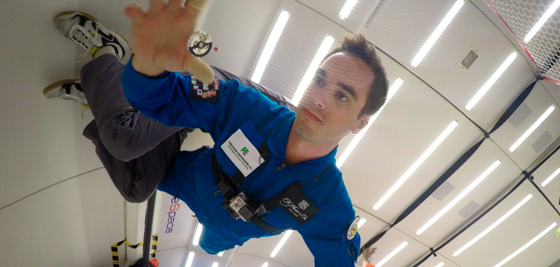
To improve the stability and quality of the chronometric performance of its calibres, H. Moser & Cie took part in the first Swiss parabolic flight.
The 22 September saw a landmark advance for the Schaffhausen-based company, the first manufacturer to perform tests in weightlessness and in hypergravity on its movements and escapements. The participants met up at Dübendorf military air base where the Zero-G aircraft, specially designed for experimental flights of this kind and managed by the noveSpace company, was awaiting the technical teams and lovers of intense sensations. This first Swiss parabolic flight was organized by the University of Zurich which had brought together a number of enterprises that wanted to test their products under rare and extreme conditions. The flight participants were kitted out with special suits and miniature cameras to immortalize their experience. The test equipment for its part had been prepared with the utmost care and was firmly secured to the aircraft floor to prevent it from breaking loose during the weightless phase. The aircraft then took off for the South of France where an air zone above the Mediterranean has been specially set aside for exceptional flights of this kind.
So what is a parabolic flight? The Zero-G aircraft, an Airbus A310 specially chartered by Lufthansa Technik, describes a parabola with a 47° ascent and descent. In just 20 seconds it climbs 2,500 metres, ascending from 6,000 to 8,500 metres. When it reaches the apex of its parabola, the occupants - and of course the equipment undergoing tests - benefit from 20 seconds in a weightless state, moments of genuine elation when the weight of the whole body is cancelled out. The aircraft repeats the same scenario fifteen times to achieve a high degree of accuracy in the tests.
Edouard Meylan, CEO of H. Moser & Cie, lead tests on board the Airbus that made the first Swiss parabolic flight, with assistance from sister company Precision Engineering. These tests were possible under such exceptional conditions thanks to the team at Witschi Electronics as well as in-flight support from their engineer Johannes Mayr. Edouard Meylan oversaw tests on various escapements to determine their behaviour in extreme weightlessness and hyper-gravity. This included an amplitude test on escapements including an original Straumann Double Hairspring, a paramagnetic hairspring and variants of hairsprings with a Breguet overcoil. Other movements included in the flight were measured for analysis after the flight, and a set of movements tested for stability that will equip a new series from H. Moser & Cie. «The tests we made fall within the framework of advanced research conducted by our sister company, Precision Engineering,» says Edouard Meylan. «Precision Engineering tests include those for new materials in escapements and hairsprings, as well as different hairspring end-curves, varying frequencies and lubrication. We test for shock resistance, magnetic fields, and in extreme temperatures, as well as for other characteristics, to ensure the stability of our components. Taking part with tests onboard the first Swiss parabolic flight is a unique opportunity, which we have been able to seize because we are independent and we produce our own regulating organs.»
As members of Moser Watch Holding, H. Moser & Cie and Precision Engineering are known for their exceptional watches and regulating organs. Like H. Moser & Cie which produces only 1,200 watches a year, Precision Engineering specializes in very special mid and small series of hairsprings. With a production of 50,000 regulating organs per year, Precision Engineering is a major player in the watch industry and provides customized solutions. Edouard Meylan adds: «The tests and the pioneering work we have done on the 22th September will enable us to improve the stability and quality of our timepieces as well as their isochronous performance. These results will guide our continued research, an ultimately help us achieve several patent applications. The data and experience gleaned during this experience will enrich our development process for regulating organs.»
Precision Engineering
Precision Engineering is a specialist in watch movement components for escapements, including the development from initial design to final production of a quality product ready to be integrated into a watch movement it must regulate. The enterprise is one of the only companies in the world able to develop and manufacture alloys for the manufacture of self-compensating hairsprings. With its innovative concepts, client orientation and its unique material expertise in manufacturing and assembly of escapement components, it is able to define and make the product perfectly matched to the needs of its customers. Precision Engineering is an independent company incorporated into Moser Watch Holding in 2012.
October 01, 2015


 News
News